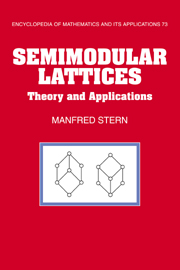Book contents
- Frontmatter
- Contents
- Preface
- 1 From Boolean Algebras to Semimodular Lattices
- 2 M-Symmetric Lattices
- 3 Conditions Related to Semimodularity, 0-Conditions, and Disjointness Properties
- 4 Supersolvable and Admissible Lattices; Consistent and Strong Lattices
- 5 The Covering Graph
- 6 Semimodular Lattices of Finite Length
- 7 Local Distributive
- 8 Local Modularity
- 9 Congruence Semimodularity
- Master Reference List
- Table of Notation
- Index
3 - Conditions Related to Semimodularity, 0-Conditions, and Disjointness Properties
Published online by Cambridge University Press: 05 May 2010
- Frontmatter
- Contents
- Preface
- 1 From Boolean Algebras to Semimodular Lattices
- 2 M-Symmetric Lattices
- 3 Conditions Related to Semimodularity, 0-Conditions, and Disjointness Properties
- 4 Supersolvable and Admissible Lattices; Consistent and Strong Lattices
- 5 The Covering Graph
- 6 Semimodular Lattices of Finite Length
- 7 Local Distributive
- 8 Local Modularity
- 9 Congruence Semimodularity
- Master Reference List
- Table of Notation
- Index
Summary
Mac Lane's Condition
Summary. In Chapter 2 we dealt with M-symmetry, a condition related to semimodularity in the sense that the two conditions are equivalent in lattices of finite length. Wilcox's concept of M-symmetry is one important approach to the question of replacing upper semimodularity by a condition that is nontrivially satisfied in lattices having continuous chains. Another approach is that of Mac Lane [1938], at which we cast a glance here. His condition will be given in two equivalent forms. We study the interrelationships between Mac Lane's condition, semimodularity, Birkhoff's condition, and M-symmetry and show, among other things, that these conditions are equivalent in upper continuous strongly atomic lattices.
In atomistic lattices, the Steinitz–Mac Lane exchange property [condition (EP)] is equivalent to the atomic covering property [condition (C)] and thus to upper semimodularity [condition (Sm)] (see Theorem 1.7.3). On the other hand, the conditions (Sm), (EP), and (C) are trivially satisfied in lattices with continuous chains. It was this criticism of (Sm) that led Wilcox [1938], [1939] to introduce M-symmetric lattices (cf. Chapter 2).
Mac Lane [1938] was led in his investigations to an “exchange axiom,” denoted by him as condition (E5), which is stronger than (Sm) and goes in a different direction than M-symmetry. Like M-symmetry, Mac Lane's condition does not involve any covering relation. Mac Lane's point of departure was the following condition due to Menger [1936] : If p is an atom and a, c are arbitrary elements, then p ≰ a ∨ c implies (a ∨ p) ∧ c = a ∧ c. Mac Lane called this condition Menger's exchange axiom and denoted it by (E3).
Information
- Type
- Chapter
- Information
- Semimodular LatticesTheory and Applications, pp. 110 - 148Publisher: Cambridge University PressPrint publication year: 1999
